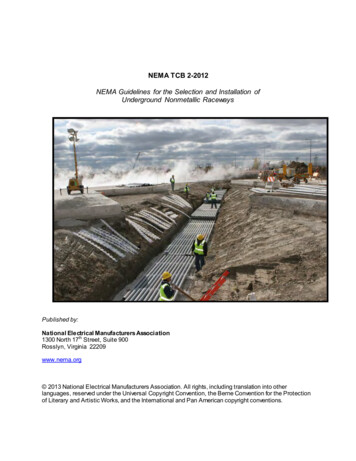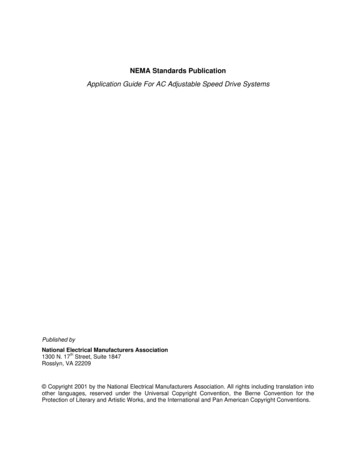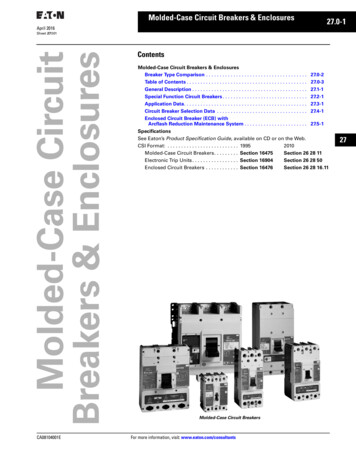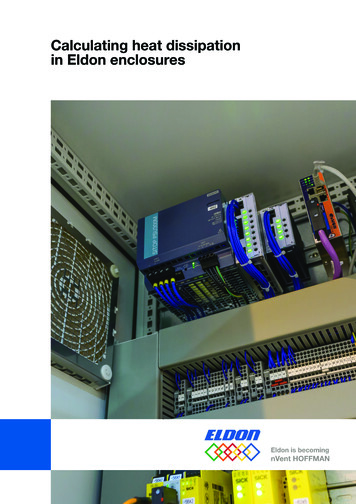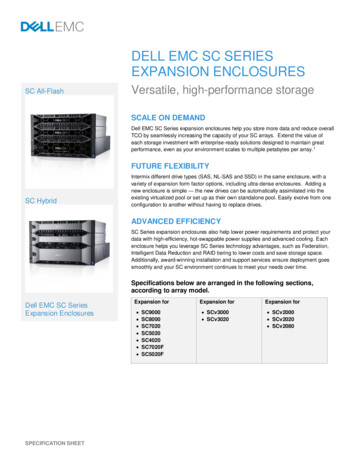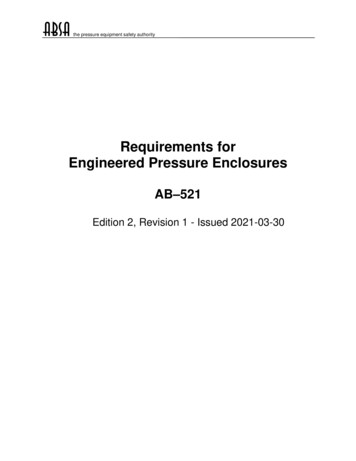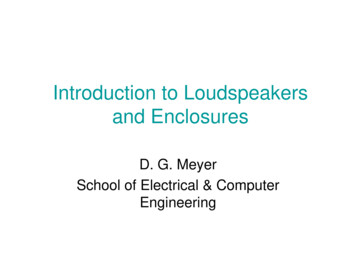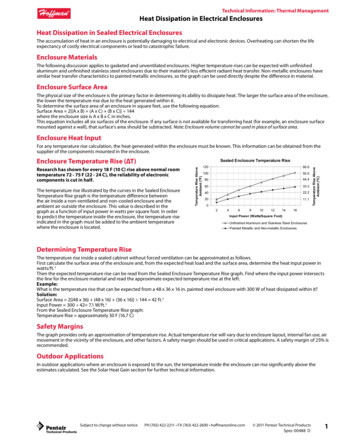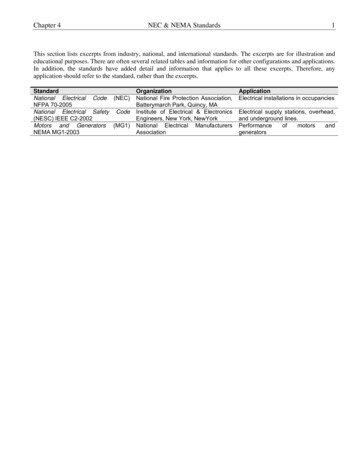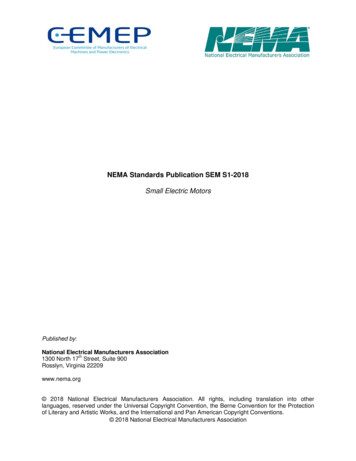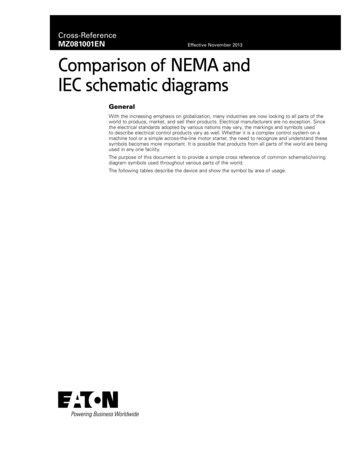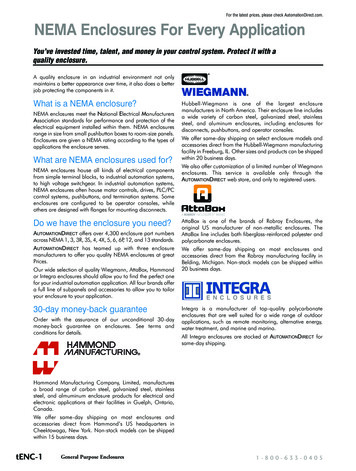
Transcription
For the latest prices, please check AutomationDirect.com.NEMA Enclosures For Every ApplicationYou’ve invested time, talent, and money in your control system. Protect it with aquality enclosure.A quality enclosure in an industrial environment not onlymaintains a better appearance over time, it also does a betterjob protecting the components in it.What is a NEMA enclosure?NEMA enclosures meet the National Electrical ManufacturersAssociation standards for performance and protection of theelectrical equipment installed within them. NEMA enclosuresrange in size from small pushbutton boxes to room-size panels.Enclosures are given a NEMA rating according to the types ofapplications the enclosure serves.What are NEMA enclosures used for?NEMA enclosures house all kinds of electrical componentsfrom simple terminal blocks, to industrial automation systems,to high voltage switchgear. In industrial automation systems,NEMA enclosures often house motor controls, drives, PLC/PCcontrol systems, pushbuttons, and termination systems. Someenclosures are configured to be operator consoles, whileothers are designed with flanges for mounting disconnects.Do we have the enclosure you need?AutomationDirect offers over 4,300 enclosure part numbersacross NEMA 1, 3, 3R, 3S, 4, 4X, 5, 6, 6P, 12, and 13 standards.AutomationDirect has teamed up with three enclosuremanufacturers to offer you quality NEMA enclosures at greatPrices.Our wide selection of quality Wiegmann, AttaBox, Hammondor Integra enclosures should allow you to find the perfect onefor your industrial automation application. All four brands offera full line of subpanels and accessories to allow you to tailoryour enclosure to your application.30-day money-back guaranteeOrder with the assurance of our unconditional 30-daymoney-back guarantee on enclosures. See terms andconditions for details.Hubbell-Wiegmann is one of the largest enclosuremanufacturers in North America. Their enclosure line includesa wide variety of carbon steel, galvanized steel, stainlesssteel, and aluminum enclosures, including enclosures fordisconnects, pushbuttons, and operator consoles.We offer same-day shipping on select enclosure models andaccessories direct from the Hubbell-Wiegmann manufacturingfacility in Freeburg, IL. Other sizes and products can be shippedwithin 20 business days.We also offer customization of a limited number of Wiegmannenclosures. This service is available only through theAutomationDirect web store, and only to registered users.AttaBox is one of the brands of Robroy Enclosures, theoriginal US manufacturer of non-metallic enclosures. TheAttaBox line includes both fiberglass-reinforced polyester andpolycarbonate enclosures.We offer same-day shipping on most enclosures andaccessories direct from the Robroy manufacturing facility inBelding, Michigan. Non-stock models can be shipped within20 business days.Integra is a manufacturer of top-quality polycarbonateenclosures that are well suited for a wide range of outdoorapplications, such as remote monitoring, alternative energy,water treatment, and marine and marina.All Integra enclosures are stocked at AutomationDirect forsame-day shipping.Hammond Manufacturing Company, Limited, manufacturesa broad range of carbon steel, galvanized steel, stainlesssteel, and almuminum enclosure products for electrical andelectronic applications at their facilities in Guelph, Ontario,Canada.We offer same-day shipping on most enclosures andaccessories direct from Hammond’s US headquarters inCheektowaga, New York. Non-stock models can be shippedwithin 15 business days.tENC-1General Purpose Enclosures1-800-633-0405
For the latest prices, please check AutomationDirect.com.How to Select Your Enclosure1. What kind of environment is yourenclosure going to be in and whatlevel of protection do you need?Your enclosure’s primary function is to protect the equipmentinside it from the surrounding environment. Therefore, youneed to understand the environment where the enclosure willbe located and select the appropriate level of protection.An enclosure’s level of protection is defined by its NEMA rating.Refer to “What Do the NEMA Ratings Mean?” later in thissection for more information.Keep in mind that it is just as important not to over-specify theprotection level of your enclosure as it is to under-specify, asincreasing the protection level typically increases the cost of theenclosure.4. Determine your thermalmanagement needs.Your enclosure must be able to dissipate the heat generated bythe components inside of it either alone or by adding a coolingdevice. You might be able to side-step additional cooling byupsizing your enclosure to increase the surface area throughwhich heat is transferred to the atmosphere.If additional cooling is required, AutomationDirect has manydevices to choose from. But always remember that the heatdissipation method you select must be compatible with theenclosure’s NEMA rating.2. Determine your securityrequirements.For some applications, a simple louver plate will provideadequate heat dissipation. A fan kit and louver combinationis your next most economical ventilation option. For smallenclosures, a vortex cooler using compressed air is anotheroption. A sealed enclosure may require a heat exchanger oran air conditioner controlling the internal temperature withoutintroducing outside air and its contaminants.Your enclosure may also need to protect its contents fromunauthorized access to the components it houses.If you need help with these calculations, go to e environment.html.AutomationDirect has options to meet a wide variety ofsecurity needs. For low-risk installations, a screw cover,lift-off cover, or Single Door with clamps may be sufficient. Inhigher risk installations, an enclosure with keylocking and/orpadlocking capabilities may be needed.An enclosure may also require heating where environmentalconditions are conducive to condensation and/or ice formationinside the enclosure.If you cannot find a stock enclosure with the security featuresthat you need, AutomationDirect offers replacement locksand latches that you can retrofit to your enclosure.3. Determine the size enclosureyou need.Physical space for your components is not the only requirement.Considerations like heat dissipation and venting must be takeninto account.First, determine the height and width for your enclosure by layingout the footprint space needed for your control componentson a standard subpanel size. Remember to consider themounting holes for the subpanel when planning the requiredfootprint space. The size of the enclosure will determine if youneed a Single Door, two-door, or wall-mount. The height andwidth of your enclosure will determine whether it should be awall-mount, floor-mount, or freestanding enclosure.Next, you’ll need to determine your panel depth. Rememberthat the subpanel mounting takes up a small portion of thedepth. Also, any pushbuttons, operator interfaces, indicators,meters, etc., that you plan to mount on the enclosure door willoccupy some enclosure depth.Finally, you must allow for heat dissipation [see step 4]. If youhave estimated component sizes or heat generation, it’s alwaysbetter to oversize the enclosure when you have the availablespace.For assistance in finding the enclosure series that meets yourneeds, refer to the “Enclosure Attributes” chart later in thissection.tENC-2General Purpose EnclosuresUnfortunately, we cannot make these determinations for youas all control applications are different. Conservative choicesincrease your margin of safety and allow for future changes.5. Choose your accessories.AutomationDirect offers a wide range of accessories for ourenclosures. Subpanels - our enclosures do not come with subpanelsunless specified in the product description. Mounting alternatives - floor stand kits, mounting feet,casters, and pole-mounting kits Drip shields for outdoor enclosures Window kits Folding shelves Hole seals and hole plugs Adapter plates for disconnects Grounding accessories Replacement locks and latches Electrical interlocks Print pockets Panel-mounting accessories - swing-out panel kits, adjustabledepth-mounting kits, panel supports for heavily-loadedpanels, and dead front kits Frames, channels and rails for rack-mounted equipment Terminal brackets and straps, mounting channels, grid straps,and DIN-rails Touch-up paint Replacement gaskets1-800-633-0405
For the latest prices, please check AutomationDirect.com.What Do The NEMA Ratings Mean?The National Electrical Manufacturers Association (NEMA) is a US Manufacturers Organization which actively promotesstandardized product specifications for electrical apparatus. While NEMA does not actually test products, it establishes theperformance criteria for enclosures intended for specific environments.NEMA standards describe each type of enclosure in general and functional terms, and specifically omits reference to constructiondetails. In other words, NEMA specifies what an enclosure must do, not how to manufacture it. This is also true about theEN 60.529/IEC 529.NEMA performance criteria and test methods are used by Underwriters Laboratories (UL) and the Canadian Standards Association(CSA) as guidelines for investigation and listing of electrical enclosures. The tested enclosures are then authorized to carry a labelby UL or CSA to prove it has passed the required tests and meets the applicable UL and CSA standard.NEMA ClassificationsNEMA 1 enclosures are typically used for protecting controls and terminations from objects and personnel. This style ofenclosure, while offering a latching door, does not have a gasketed sealing surface. NEMA 1 enclosures are used in applications where sealing out dust, oil, and water is not required.NEMA 2 enclosures are intended for indoor use primarily to provide a degree of protection against limited amounts of fallingwater and dirt.NEMA 3 enclosures are intended for outdoor use primarily to provide a degree of protection against windblown dust, rain,sleet, and external ice formation.NEMA 3R enclosures are typically used in outdoor applications for wiring and junction boxes. This style of enclosureprovides protection against falling rain, sleet, snow, and external ice formation. Indoors they protect against dripping water.This style of enclosure does not have a gasketed sealing surface. Some models have hasps for padlocking.NEMA 3RX enclosures are typically used in outdoor applications for wiring and junction boxes. This style of enclosureprovides protection against falling rain, sleet, snow, and external ice formation and provides an additional level of protection against corrosion. Indoors they protect against dripping water. This style of enclosure does not have a gasketed sealingsurface. Some models have hasps for padlocking.NEMA 3S enclosures are intended for outdoor use primarily to provide a degree of protection against windblown dust, rain,sleet, and to provide for operation of external mechanisms when ice laden.NEMA 4 enclosures are used in many applications where an occasional washdown occurs or where machine tool cutter coolantis used. They also serve in applications where a pressurized stream of water will be used. NEMA 4 enclosures are gasketed andthe door is clamped for maximum sealing.NEMA 4X enclosures are made of stainless steel, aluminum, fiberglass, or polycarbonate. NEMA 4X enclosures are used in harshenvironments where corrosive materials and caustic cleaners are used. Applications include food, such as meat/poultry processingfacilities, where total washdown with disinfectants occur repeatedly, and petro-chemical facilities, including offshore petroleumsites.NEMA 5 enclosures are intended for indoor use primarily to provide a degree of protection against settling airborne dust,falling dirt, and dripping non-corrosive liquids.NEMA 6 enclosures are intended for indoor or outdoor use primarily to provide a degree of protection against the entry ofwater during occasional, temporary submersion at a limited depth.NEMA 6P enclosures are intended for indoor or outdoor use primarily to provide a degree of protection against the entry ofwater during prolonged submersion at a limited depth.NEMA 11 enclosures are intended for indoor use primarily to provide, by oil submersion, a degree of protection to enclosedequipment against the corrosive effects of liquids and gases.NEMA 12 enclosures are intended for indoor use to provide a degree of protection against drips, falling dirt, and drippingnon-corrosive liquids. NEMA 12 enclosures are most commonly used for indoor applications of automation control and electronic drives systems, including packaging, material handling, non-corrosive process control, and manufacturing applications.Gasketed doors seal the enclosure’s contents from airborne contaminants and non-pressurized water and oil.NEMA 12K enclosures with knock-outs are intended for indoor use primarily to provide a degree of protection against dust,falling dirt, and dripping non-corrosive liquids other than at knock-outs.NEMA 13 enclosures are intended for indoor use primarily to provide a degree of protection against dust, spraying of water,oil, and non-corrosive coolant.tENC-3General Purpose Enclosures1-800-633-0405
For the latest prices, please check AutomationDirect.com.What Do The NEMA Ratings Mean?Comparison of Non-Hazardous Applications for Indoor LocationsProvides a Degree of Protection Against theFollowing Environmental ConditionsEnclosure NEMA Type1*2*44X566P111212K13Incidental contact with the enclosed equipmentXXXXXXXXXXXFalling dirtXXXXXXXXXXXXXXXXXXXXDust, lint, fibers, and flyingsXXXXXXXHose down and splashing waterXXXXXXXFalling liquids and light splashingXOil and coolant seepageOil or coolant spraying and splashingXCorrosive agentsXXOccasional temporary submersionXOccasional prolonged submersionXXX*These enclosures may be ventilated. However, Type
NEMA 3R enclosures are typically used in outdoor applications for wiring and junction boxes. This style of enclosure provides protection against falling rain, sleet, snow, and external ice formation. Indoors they protect against dripping water. This style of enclosure does not have a gasketed sealing surface.
